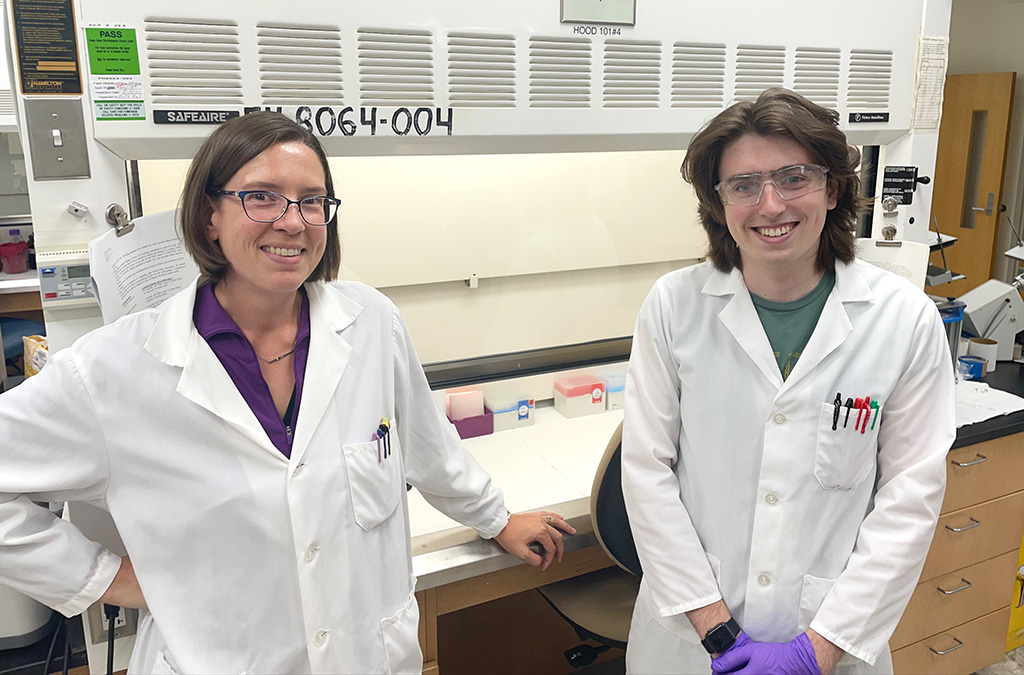Prestigious UW–Madison award recognizes meaningful collaborations, impactful research among undergraduates
By Brianna Foth
Over the last four years, 14 students from the University of Wisconsin–Madison School of Pharmacy’s Pharmacology and Toxicology undergraduate program — a program that averages just around 20 graduates each year — have been selected to receive one of the university’s most prestigious undergraduate research awards: the Hilldale Undergraduate/Faculty Research Fellowship.
In 2022, four more PharmTox students have been selected for the competitive fellowship, continuing a long tradition of PharmTox students earning the $3,000 scholarship the award provides.
For awardees Kegan Skalitzky, Nina Wood, Siyang Peng, and William Naviaux, the award was a welcome — and well-earned — surprise.
“When I got it, I was just ecstatic,” says Wood. “I told my advisor about it, and she was thrilled.”
“Independent research is a crucial and formative component of our PharmTox curriculum. Students take what they’ve learned in classrooms and use it in real-life applications.”
—Kendra Gurnee
The fellowship recognizes undergraduate students’ significant intellectual contributions to their research, as well as the potential impacts of their projects and the extent of their collaboration with their research mentors. Awardees are also invited to present their research findings at the university’s yearly Undergraduate Symposium, offering a valuable opportunity for students to share the outcomes and real-world impact of their research.
“Independent research is a crucial and formative component of our PharmTox curriculum,” says Kendra Gurnee, PharmTox program coordinator. “Students take what they’ve learned in classrooms and use it in real-life applications.”
The 2022 PharmTox winners’ projects take on research topics ranging from skeletal muscle aging to the accurate detection of methamphetamine in homes.
Treating urinary tract dysfunction
For PharmTox student Kegan Skalitzky, the experience of working within the program’s robust research curriculum — which encourages students to choose from a diverse range of research areas that aren’t limited to the School of Pharmacy — was part of what initially motivated her to apply for the fellowship.

“A lot of us want to be in the lab, so it made sense for us to apply and take advantage of these opportunities, she says. “It’s awesome that so many of us applied and got the fellowship.”
Skalitzky has been working with the Ricke Lab under the direction of UW Department of Urology Professor William Ricke and Assistant Scientist Petra Popovics since her freshman year. Her research involves studying the bladder and the role of a structural protein called osteopontin in the development of lower urinary tract dysfunction (LUTD) in men around the age of 40 and older. Osteopontin is a known driver of chronic inflammation and fibrosis, both key features of LUTD.
She hopes that by learning more about the mechanisms underlying LUTD, and specifically the role inflammation plays in its development, future researchers will be able to develop more precise, targeted drugs to relieve urinary tract symptoms for aging men.
“It really comes down to understanding how the disease works, to determine how to treat patients as effectively as we can,” she says.
Preventing skeletal muscle aging
Sarcopenia, also known as skeletal muscle aging, is a condition marked by the gradual loss of muscle mass that primarily affects adults over age 30. Nina Wood’s project, in the Anderson Lab led by Professor of Medicine Rozalyn Anderson from the UW–Madison Department of Medicine’s Division of Geriatrics and Gerontology, will be looking into the role inflammation plays in skeletal muscle aging.

“With aging, the skeletal muscles waste away both in size and power — that’s experienced by everyone and it’s detrimental to health,” says Wood. “There’s no cure or treatment for it; the only thing you can do is exercise, which is not always a viable option for some people.”
Researchers recently developed a chemical compound called AdipoRon that can stimulate the same receptors activated during exercise to help prevent sarcopenia. However, it’s unknown exactly which mechanisms allow the drug to be effective. Through her research, Wood hopes to learn whether the drug works in part by reducing inflammation.
“We know that AdipoRon prevents skeletal muscle aging. We also know that skeletal muscle aging is really tightly connected with inflammation,” says Wood. “So now I’m just trying to connect those two dots, to see if inflammation is also reduced by AdipoRon.”
Detecting methamphetamine
Methamphetamine residue in residential homes, which can be present when new tenants or homeowners move in, can be especially harmful to children. William Naviaux’s research is hoping to improve the detection of methamphetamine residue and the effectiveness and accuracy of methamphetamine test kits.

“When people are manufacturing methamphetamines illicitly in clandestine labs, the leftover residue is really hard to clean up. And there currently aren’t any great or peer-reviewed ways to detect those residues,” says Naviaux. To solve that problem, he is working with Assistant Professor Heather Barkholtz, who holds a joint faculty position between the School of Pharmacy’s Pharmaceutical Sciences Division and the Wisconsin State Laboratory of Hygiene (WSLH) — the state’s public, environmental, and occupational health laboratory, which provides services including public health programs and laboratory proficiency testing.
By ensuring that the tests are effective, state and local health officials will be much better able to monitor residue levels and protect community members from moving into unsafe living environments.
“Having a good method for testing ensures that people have the ability to make sure these environments are safe,” Naviaux says.
Predicting flu strains
Siyang Peng’s project seeks to understand a phenomenon that happens every year: the development of new strains of the influenza virus.

Overseen by the Friedrich Lab led by Professor Thomas Friedrich of the School of Veterinary Medicine’s Department of Pathobiological Sciences, Peng is studying the evolution of the influenza virus through observing its transmission between ferrets. By learning more about how this evolution takes place, Peng hopes to improve scientists’ ability to predict future strains, which has important implications for the development of the flu vaccine each year.
“Understanding more about flu and viral evolution would help us in the long run,” she says. “It’s important for us to understand more about how these strains evolve, so that we can better protect ourselves against them.”
Having been selected to receive the fellowships, the four PharmTox students will not only benefit from the stipend the award provides, but also from its reinforcement of the importance of their research and of their ability to carry out that research independently.
“Getting the reassurance that you’re capable of completing this project, and that you’ll be given money to do it — it’s amazing,” says Skalitzky. “It’s apparent that we really care about our research and that our coursework is preparing us for it. It feels good to positively represent the School of Pharmacy.”